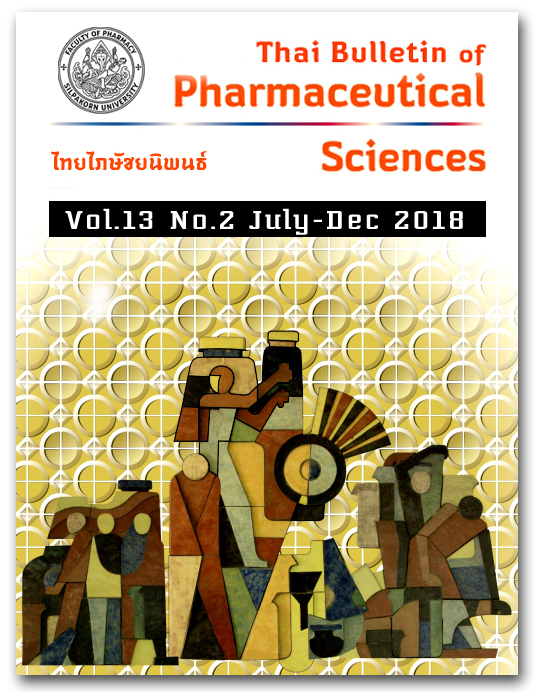PERCEPTION, AWARENESS AND BEHAVIOR TOWARD SOCIAL NETWORKS USE IN PHARMACY SERVICES AMONG HOSPITAL PHARMACISTS UNDER THE JURISDICTION OF THE MINISTRY OF PUBLIC HEALTH IN THE UPPER NORTH OF THAILAND
DOI:
https://doi.org/10.69598/tbps.13.2.99-115Keywords:
social networks, pharmacy services, behavior in social networks usageAbstract
The purpose of this research was to determine perception, awareness and behavior toward social network usage within pharmacy services among hospital pharmacists under the jurisdiction of the Ministry of Public Health in 8 upper Northern provinces of Thailand, including Chiang Rai, Chiang Mai, Nan, Phayao, Phrae, Lampang, Lamphun and Mae Hong Son. A quota sample selection was used in this study. Data were collected from mailed questionnaires with 355 (75.85%) responses in total. The data were analyzed using SPSS version 17.0. Descriptive statistics were presented as percentage, frequency, mean and standard deviation. The results showed that the majority of participants were female (78.60 %) with an average age of 36.18 ± 6.58 years. Most participants worked in community hospitals (57.70 %) and were responsible for outpatient pharmacy services (52.70 %). Smart phones were the most frequently used devices in order to connect to social networks (83.70 %) and the Line application was the most frequently used app within the pharmacy services (47.90 %). Most participants never shared information with others without prior permission (80.00 %) and never posted messages or patients’ pictures on social networks (69.60 %). Some pharmacists who posted messages or patients’ pictures did not receive any feedback (17.70 %) and some received positive feedback (13.80 %). About half of the participants sometimes checked information before sharing it with others (50.40 %). Most hospitals did not have policies for social network usage (50.40 %) and did not have administrators for social network groups (39.40 %). Participants had a high level of perceived usefulness, perceived ease of use and awareness of social network usage, with results of 3.79 ± 0.31, 3.90 ± 0.42 and 3.89 ± 0.31 respectively, based on a full score of 5. It is suggested that The Pharmacy Council of Thailand should publish social network use guidelines for pharmacists so that they would be able to use social networks effectively with maximum benefit and safety.
References
2. Barrett P, Bruecki M, Cain J, Edwards M, Fox E, Harvey B et al. ASHP statement on use of social media by pharmacy professionals. Am J Health Syst Pharm. 2012; 69:2095–7.
3. Shcherbakova N. and Shepherd M. Assessment of Internet and Social Network Use for Professional Purposes by Texas Independent Community Pharmacists Final Report. 2013; (June):1–30.
4. Lorsuwannarat T. Management Information System 2nd Edition. Bangkok. S & G Graphic. 2002.
5. Yamane T. Statistics: an introductory analysis. New York: Harper and Row. 1973.
6. Eakanunkul A., Kaewboonsert C., Wongsampun N., Suwannaprom P. Knowledge and Perceptions of Hospital Pharmacists towards Biological Products and Biosimilars. Thai J Pharm Pract. 2015;7(1):60-72. (in Thai)
7. Hemmin A. Social media consumption behaviors and opinion towards results of experiencing social media in Bangkok Metropolitan. [Master's Thesis, Science Program in Applied Statistics, Graduate School of Applied Statistics]. Bangkok: National Institute of Development Administration; 2013. (in Thai)
8. Chalongsuk R. Usage Behavior and Attitude of the Pharmacy Students of Silpakorn University toward Social Media for Education. Veridian E-J Silpakorn Univ. 2012;7(2):802-12. (in Thai)
9. Nakorn Ping Hospital bring line application to treat the patient for reducing the burden on patients travel cost savings 35 million per year. [Internet]. 2013 [cited 2015 July 6]. Available from: https://www.hfocus.org/content/2013/09/4799. (in Thai)
10. Jarupaiboon C. Satisfaction with the use of application line in ICU Neuro official communication. [Internet]. 2015 [cited 2015 April 5]. Available from: www.med.cmu.ac.th/ hospital/nis/downloads/?p=3247. (in Thai)
11. Kasemchainandh T. The factors that effect web sites accessing behavior of internet users in Bangkok. [Master's Thesis, Arts Program in Mass Communication, Faculty of Journalism and Mass Communication. Bangkok: Thammasat University; 2001. (in Thai)
12. The Code of Professional Pharmacy Ethics B.E. 1995 [updated 1995 December 21]. Government Gazette. 112(102 );63-7. (in Thai)
13. “Patient’s rights”. [Internet]. 2015. [cited 2015 September 5]. Available from: www.tmc.or.th/privilege. php. (in Thai)
14. Javanicha C. Internet and line application using for commanding and controlling in 45th Ranger Regiment Taskforce Narathiwat Province. [Master's Thesis, Public Administration Program, Faculty of Public Administration]. Pathum Thani: Western University. 2016. (in Thai)
15. Social media practices guidelines for health practitioners, 2017. Government Gazette. 134(88). (24 March, 2017). (in Thai)
16. Lorsuwannarat T. Learning Organization : from concept to practice. Bangkok. Rattanatri. 2006. (in Thai)
17. Luenam P. Concepts and evalution of technology acceptance model. Mod Manage J. 2011; 9(1):9-17. (in Thai)
18. Davis F. A technology acceptance model for empirically testing new end-user information systems: theory an results. Unpublished Doctoral dissertation, MIT Sloan School of Management. 1985.
Downloads
Published
How to Cite
Issue
Section
License
All articles published and information contained in this journal such as text, graphics, logos and images is copyrighted by and proprietary to the Thai Bulletin of Pharmaceutical Sciences, and may not be reproduced in whole or in part by persons, organizations, or corporations other than the Thai Bulletin of Pharmaceutical Sciences and the authors without prior written permission.



